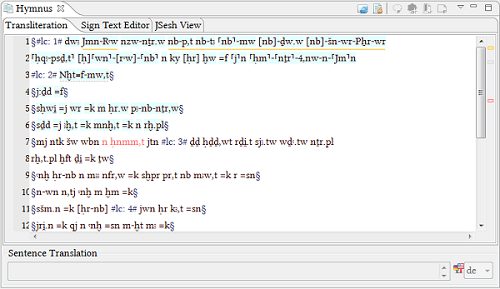The Text Editor tab is located in the upper part in the middle of the Text Corpus view. The text input field is empty as long as no text from the Corpus Navigator is selected. Upon selecting a text you will be able to transliterate it and enter hieroglyphs. This chapter provides a general description of the tab. For a step-by-step instruction of how to enter a new text please refer to the relevant chapter in the User Guide section of this manual.
The Text Editor section contains two input fields. The upper one displays either the "Transliteration", the "Sign Text Editor" or the "JSesh View" - depending on the tab selected. The lower input field displays translation of the sentence, selected with the cursor in the upper window.

Transliteration
Here you can enter or modify the transliteration of the text which you previously selected in the corpora tree. Beware of the BTS Grammar Rules, otherwise the auto-checker system will trigger an error, marked by a red square and underlined red.
Sign Text Editor
The "Sign-Text-Editor" provides the token-based presentation of the text. Initially only the transliteration is displayed there - each word / lemma in a separate box. The Lemma ID, the inflection code, the Lemma Translation and hieroglyphs of each token can be made visible via menu entry "Preferences / Preferences / Berlin Text System General / Text Editor / Sign Text Editor".
The hieroglyphic input is done in the ![]() Hieroglyph Type Writer tab below. The hieroglyphic values, entered
there, are automatically applied to the selected lemmata in the "Sign-Text-Editor" sub-tab.
Additionally to the transcription and hieroglyphs, a lemma number and inflection code will be
displayed in each word box after a successful lemmatization.
Hieroglyph Type Writer tab below. The hieroglyphic values, entered
there, are automatically applied to the selected lemmata in the "Sign-Text-Editor" sub-tab.
Additionally to the transcription and hieroglyphs, a lemma number and inflection code will be
displayed in each word box after a successful lemmatization.
JSesh View
Displays a cohesive hieroglyphic text. "dot" marks the end of the sentence (signified in "Transliteration" and "Sign Text Editor" tabs with "§" sign).
There are several buttons above the "Text-Editor" window:
![]() Load Text Lemmata
Load Text Lemmata
Loads word and sentence borders of your texts in order to be able to add a translation and to lemmatize the words and add the hieroglyphs in the next steps. Click this button after transliteration has been finished.
![]() Check Text
Lemmata, Flexcodes...
Check Text
Lemmata, Flexcodes...
Checks the completeness of text lemmatization, translation and hieroglyphic transcription.
![]() Add Annotation
Add Annotation
Adds an Annotation to the selected part of your text. It will be underlined with a gray dotted line.
![]() Add Rubrum
Add Rubrum
The active token is marked red in the text as rubrum.
![]() Add Subtext/Glosses
Add Subtext/Glosses
Adds a subtext or a gloss respectively as a "child" of your text. You can edit it separately.
![]() Add Comment
Add Comment
Adds a comment to the selected part. It will be underlined yellow.
You can use these functions also via the drop-down menu that appears when you click on the arrow on the right.
Additionally, for Annotations, Rubra and Comments, a small, rectangular bar will appear on the right side of the Text-Editor with the corresponding colour. Clicking on the bar will bring you to the marked segment of the text.
Sentence translation
At the bottom of the Text Editor tab there is a text-input field where you can enter a translation of every sentence. With the existing transliteration it is deactivated unless a lemma has been selected in the "Text editor" or until you click somewhere into the sentence. With the new transliteration it is greyed out until you press "Load Text Lemmata" - after this the text-input field will be activated. Note that you have to switch the keyboard layout from "AAeW" to standard to enter the translation.
The ![]() "Languages" icon
offers a drop-down menu with a number of languages (English, German, French, Spanish, Russian) to
choose from. Choose the language of your translation.
"Languages" icon
offers a drop-down menu with a number of languages (English, German, French, Spanish, Russian) to
choose from. Choose the language of your translation.
